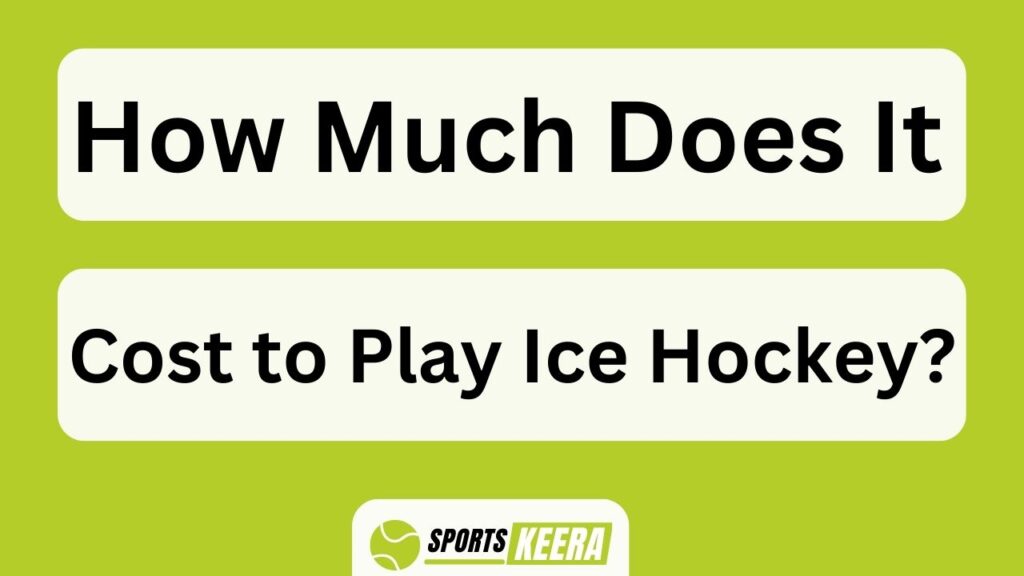How much does it cost to play ice hockey?
This question is frequently asked by individuals who are interested in pursuing this exhilarating sport. Ice hockey, known for its fast-paced action and physicality, requires a significant financial commitment.
In this article, we will explore the various expenses associated with playing ice hockey, shedding light on the equipment costs, ice time expenses, coaching and training fees, league fees, travel expenses, and additional costs that players may encounter.
To begin with, a player must invest in essential equipment such as skates, pads, helmets, sticks, and protective gear. These items can be quite costly but are crucial for ensuring safety during gameplay.
Additionally, players must consider the expenses related to accessing ice rinks and practicing regularly. Hiring professional coaches or participating in training sessions also comes at a price.
Moreover, joining competitive leagues involves paying registration fees and potentially traveling to different locations for games.
Understanding the financial aspects of playing ice hockey is essential for anyone considering this sport seriously. By delving into these cost factors comprehensively in this article, readers will gain valuable insights into the overall investment required to pursue their passion for ice hockey.
Key Takeaways How Much Does It Cost To Play Ice Hockey?
- Ice hockey requires a significant financial commitment, with expenses including equipment costs, ice time expenses, coaching and training fees, league fees, travel expenses, and additional costs.
- Equipment costs can range from a few hundred to several thousand dollars and ongoing expenses for maintenance and repair are necessary.
- Ice time expenses depend on location and the specific ice rink facility, and beginners may need to pay for skating lessons separately.
- League fees can be a significant financial commitment, but player scholarships and fundraising opportunities can help alleviate the burden.
Equipment Costs
The cost of ice hockey includes purchasing and maintaining equipment. Players must invest in a variety of gear, such as skates, helmets, shoulder pads, elbow pads, gloves, shin guards, and sticks. The initial cost for these items can range from a few hundred to several thousand dollars depending on the quality and brand chosen.
Additionally, there are ongoing expenses for maintenance and repair. Ice hockey equipment experiences wear and tear due to the physical nature of the sport, requiring regular upkeep and occasional repairs or replacements.
Furthermore, customization options can add to the overall expense. Some players choose to personalize their gear with team logos or individual designs, which often come at an extra cost.
Transitioning into discussing ice time expenses without explicitly stating it requires considering how these costs impact overall participation in ice hockey.
Ice Time Expenses
Ice time expenses can vary significantly depending on factors such as location, demand, and the specific ice rink facility. When considering ice hockey costs, it is crucial to factor in the cost of renting an ice rink. Rink rental fees often depend on the duration and frequency of usage.
Additionally, many beginners opt for skating lessons to improve their skills. These lessons are typically conducted at dedicated ice rinks or training facilities and come with a separate expense.
Apart from these direct costs, there may be additional expenses associated with equipment maintenance and sharpening skates. Understanding the various components involved in ice time expenses is important for those interested in playing ice hockey and budgeting accordingly.
Moving forward to coaching and training fees…
Coaching and Training Fees
Coaching and training fees in the context of ice hockey can significantly impact an individual’s financial commitment, but how does one determine the value of expert guidance and skill development?
Ice hockey requires specialized coaching to enhance players’ skills and foster team bonding. Skilled coaches provide valuable insights into strategies, tactics, and techniques that can help players improve their performance on the ice. They also play a crucial role in teaching teamwork, communication, discipline, and sportsmanship.
Training sessions are designed to develop specific skills such as skating, shooting, passing, and puck handling. These sessions may include drills, practice matches, video analysis, and strength conditioning exercises.
The cost of coaching and training varies depending on factors such as coach’s experience level and expertise.
Transitioning to the subsequent section about ‘league fees,’ it is important to consider all aspects of ice hockey expenses when determining its overall cost.
League Fees
League fees in ice hockey can be a significant financial commitment for players and their families, requiring careful consideration of the overall cost.
To help alleviate the burden, there are player scholarships available that can provide financial assistance to those who may not have the means to cover league fees. Additionally, fundraising opportunities such as team-sponsored events or community initiatives can help raise funds to offset league fees. These options enable players from various economic backgrounds to participate in ice hockey without being constrained by financial limitations. It is important for players and their families to explore these avenues and take advantage of any available resources.
Transitioning into the next section about travel expenses, it is crucial to understand that league fees are just one aspect of the overall costs associated with playing ice hockey at a competitive level.
Travel Expenses
This discussion will focus on the travel expenses associated with playing ice hockey.
Transportation costs, which include fuel, vehicle maintenance, and parking fees, can vary depending on the distance traveled to games or tournaments.
Accommodation expenses may arise when players need to stay overnight in hotels or rental properties.
Additionally, meal costs should be considered as players often require additional meals while away from home for extended periods of time.
Transportation
Transportation costs associated with playing ice hockey can vary depending on the distance to the rink and the availability of public transportation options. When it comes to getting to the rink, players have a few options that can help reduce costs.
One option is taking advantage of public transportation options such as buses or trains, which may offer discounted fares for athletes. Additionally, carpooling with teammates is another cost-effective way to travel together and split expenses such as gas and parking fees. By sharing rides, players can not only save money but also foster team camaraderie during their journeys to and from games or practices.
Moving on from transportation, accommodation arrangements are another important aspect to consider when calculating the overall cost of playing ice hockey.
Accommodation
In addition to transportation costs, another significant expense for ice hockey players is accommodation. Finding affordable options can be challenging, especially in areas with limited availability or high demand.
However, there are ways to mitigate this cost. One common strategy is sharing accommodations with teammates or other players to split the expenses. This not only reduces the financial burden but also fosters a sense of camaraderie and team bonding.
Many ice hockey organizations also offer housing assistance programs or have partnerships with local hotels that provide discounted rates for players. By exploring these options and being proactive in their search, players can find suitable and cost-effective accommodation during their participation in ice hockey activities.
With accommodation costs addressed, the next section will delve into another crucial aspect of playing ice hockey: meals.
Meals
To ensure optimal performance on the ice, ice hockey players must prioritize their nutritional needs by carefully planning and consuming well-balanced meals that provide an adequate intake of essential nutrients, support muscle recovery, and sustain energy levels throughout training sessions and games.
Nutritional requirements for ice hockey players include a balance of carbohydrates, protein, and healthy fats to fuel their bodies during intense physical activity. Meal planning is crucial for athletes to meet these requirements while staying within their budget. It involves selecting nutrient-dense foods such as lean meats, whole grains, fruits, vegetables, and low-fat dairy products. By strategically choosing affordable options and preparing meals in advance, players can maintain a healthy diet without breaking the bank.
This focus on nutrition not only enhances performance but also promotes overall health and wellness among ice hockey players.
Transitioning into the subsequent section about additional costs:
In addition to accommodation and meals, there are other financial considerations when it comes to playing ice hockey at a competitive level.
Additional Costs
Ice hockey also incurs various other expenses beyond the basic equipment, such as ice time rentals, training fees, and tournament registration costs.
Team fees are one of the major additional costs associated with playing ice hockey. These fees typically cover expenses like coaching salaries, facility maintenance, and administrative costs. Depending on the level of competition and location, team fees can range from a few hundred to several thousand dollars per season.
Tournament fees are another significant expense in ice hockey. Teams often participate in tournaments throughout the season to gain exposure and compete against other teams. Tournament fees cover expenses such as registration, travel, accommodation, and meals for players and coaches. These costs can vary depending on the number of tournaments attended and their locations.
It is important for prospective ice hockey players and their families to factor in these additional costs when considering the overall cost of playing ice hockey. Proper budgeting can help ensure that players have access to all necessary resources without facing financial strain.
Frequently Asked Questions
Are there any scholarships or financial aid options available for ice hockey players?
Scholarship opportunities and financial aid options are available for ice hockey players. These resources can help alleviate the costs associated with playing the sport, making it more accessible to individuals from various financial backgrounds.
How often should I replace my ice hockey equipment?
Ice hockey equipment should be replaced when it no longer provides adequate protection or performance. Regular maintenance, such as cleaning and checking for wear and tear, can help prolong the lifespan of the equipment.
Are there any age restrictions for joining a hockey league?
Age restrictions for joining a hockey league vary depending on the specific league and its policies. Some leagues may have minimum age requirements, while others may have maximum age limits or divisions based on age groups.
Can I rent ice time for private practice sessions?
Ice time can be rented for private practice sessions in ice hockey. This allows individuals or teams to have dedicated time on the ice for training and skill development. The cost of renting ice time may vary depending on factors such as location, duration, and demand.
Are there any opportunities for sponsorship or endorsement deals for ice hockey players?
Ice hockey players have various opportunities for sponsorship and endorsement deals. These partnerships can provide financial support, equipment, and exposure for athletes. Like a well-tailored jersey, these collaborations can elevate the player’s career and open doors to new opportunities.
Conclusion
The cost of playing ice hockey can vary depending on various factors. Equipment costs, including skates, pads, and sticks, can range from a few hundred to several thousand dollars.
Ice time expenses for practices and games also add up over time. Coaching and training fees are another expense to consider for those seeking professional guidance. League fees contribute to the overall cost, with some leagues charging hundreds or even thousands of dollars per season. Additionally, travel expenses may be incurred for tournaments and away games.
Overall, the cost of playing ice hockey can be significant but varies greatly depending on individual circumstances.
One interesting statistic is that according to a survey conducted by USA Hockey in 2019, the average annual cost of playing ice hockey at the youth level was approximately $2,500 per player. This figure includes equipment costs, league fees, coaching/training fees, and travel expenses. This statistic highlights the financial commitment required for young athletes interested in pursuing ice hockey seriously and showcases the dedication of players and their families who invest in this sport.




